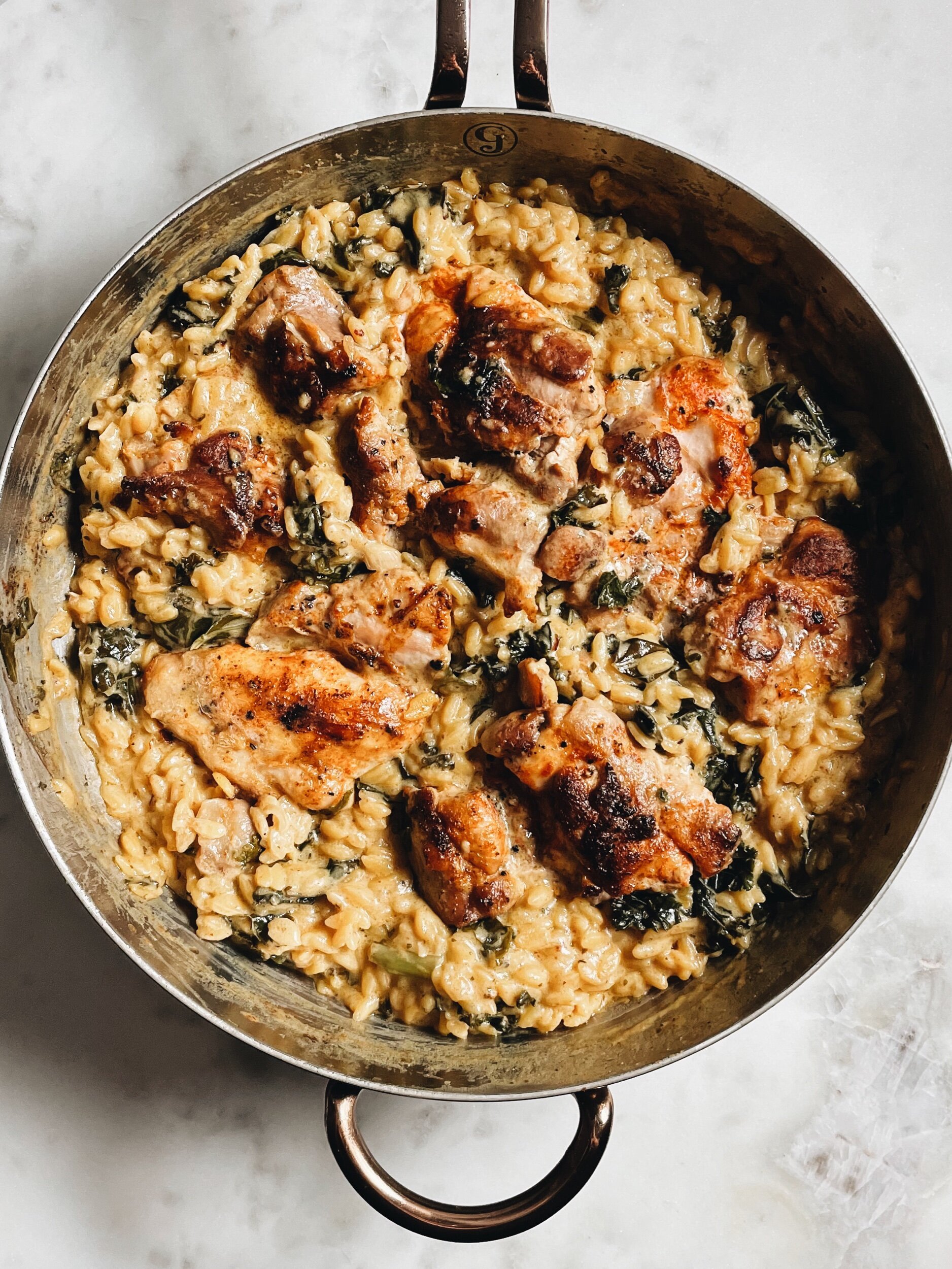skillet chicken orzotto with boursin
January, a month that’s traditionally about a year long, really seemed to break a lot of people in a pandemic winter. There were whole weeks in there where I’m pretty sure the most outside-world exposure I got was opening a window. However, the desperation of a deep hibernation state also breeds creation, and sure enough, some real stars were born. Orzotto—orzo risotto—is one of them.
Where risotto can be a bit of a brat, even in the oven, orzo is a more amiable and compliant and easygoing substitute. It doesn’t require the starches be gently coaxed out of it with broth at the exactly perfect temperature or stirred at the right speed. It just goes in the oven and soaks up liquid til it’s done. The texture also comes out less dense but still luxurious, and solidly risotto-adjacent.
The other benefit is the near impossibility of screwing it up. Round one of testing involved still-semi-frozen chicken that stuck to the pan and ripped apart, forgotten butter, and broth added before the cheese so that the whole thing turned into clumpy soup. Guess what? IT WAS STILL GOOD. And made correctly, it’s incredible.
as close as we get to “eating at the bar” these days
This dish is very on brand for me in that you don’t really need to follow the directions as long as you get the proportions right. You absolutely need 2 1/2 cups of liquid for every cup of orzo. The rest is just a guideline. Chicken thighs are more forgiving, but you can use breasts. Any wine or broth will work. Truthfully, not even the Boursin is necessary—I have used goat, feta, even a pecorino and cream blend—but the Boursin is a vibe and worth trying once.
RECIPE
Orzo, but make it risotto. This hands-off, oven-baked orzotto comes together in one skillet, with plenty of leafy greens and seared chicken thighs that braise right on top; Boursin cheese folded in at the end gives it a luxurious creamy texture.
Effortful time: 10 minutes
Total time: 25 minutes
Serves 4; this makes uniquely fabulous leftovers
YOU NEED
2 tbsp. olive oil
2 tbsp. butter
1 1/4 lb. boneless, skinless chicken thighs
1 small shallot, finely chopped
2 cloves of garlic, minced
1 cup white wine; I keep Sutter Home minis around just for this purpose
1 1/2 cups low sodium chicken broth; I use Better than Bouillon—heat it up first!
1 cup dry orzo
1 package Boursin garlic and herb cheese
A few big handfuls of chopped kale, spinach, or green of your choice
Juice of a lemon
Salt and pepper to taste
Chili flakes, optional
MAKE IT
Get prepped. Preheat the oven to 400°F. Salt and pepper the chicken thighs and heat your stock.
Cook your chicken. In a large oven-safe skillet, heat the olive oil over medium heat. Brown the chicken thighs, 4 minutes per side, until golden brown (it’s okay if they’re not cooked through yet). Remove to a plate or a piece of foil.
Wilt the greens. In the hot chicken-fat-oil, melt the butter. Sauté the garlic and shallot until fragrant, about 30 seconds. Add the greens and stir to coat in oil. Cook until they’ve shrunk substantially; how long that takes depends on the green, but usually about 2 minutes.
Toast the orzo. Add the orzo to the pan and stir so the orzo is coated in oil and begins to darken, about 2 minutes.
Deglaze the orzo. Pour in the white wine and scrape up all the brown bits. Remove from heat.
Turn it into orzotto. Pour in the broth and stir one more time. Nestle the chicken thighs back into their brothy orzotto bed.
Bake the orzotto. 20 minutes, covered.
Finish the orzotto. When it comes out, it will look sort of… pooled. This is right! Squeeze lemon juice all over the orzotto mixture. Remove the chicken to a clean plate and stir the boursin cheese into the orzotto. It will be thick, creamy, and luscious after this. Then put the chicken back.
Serve it up. Sprinkle with chili flakes and serve. Reheats best on low, with more water than you think — the orzo will continue to absorb it after refrigeration and during a second cooking.

